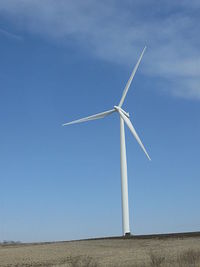Betz limit: Difference between revisions
J.williams (talk | contribs) m (1 revision imported) |
No edit summary |
||
| Line 1: | Line 1: | ||
[[Category:Done | [[Category:Done 2018-07-20]] | ||
[[File:Windturbino.jpg|200px|thumb|Figure 1. A wind turbine. The Betz limit gives the maximum amount of power it can convert into motion and electricity.<ref>Wikimedia Commons [Online], Available: http://commons.wikimedia.org/wiki/File:Wind_turbine_walnut_iowa.jpg</ref>]] | [[File:Windturbino.jpg|200px|thumb|Figure 1. A wind turbine. The Betz limit gives the maximum amount of power it can convert into motion and electricity.<ref>Wikimedia Commons [Online], Available: http://commons.wikimedia.org/wiki/File:Wind_turbine_walnut_iowa.jpg</ref>]] | ||
<onlyinclude>The '''Betz limit''' is the theoretical maximum [[efficiency]] for a [[wind turbine]], conjectured by German physicist Albert Betz in 1919.<ref name=bet>REUK, ''Betz Limit - Wind'' [Online], Available: http://www.reuk.co.uk/Betz-Limit.htm</ref> Betz concluded that this value is '''59.3%'''</onlyinclude>, meaning that at most only 59.3% of the [[kinetic energy]] from [[wind]] can be used to spin the turbine and generate [[electricity]]. In reality, turbines cannot reach the Betz limit, and common efficiencies are in the 35-45% range.<ref name=bet/> | <onlyinclude>The '''Betz limit''' is the theoretical maximum [[efficiency]] for a [[wind turbine]], conjectured by German physicist Albert Betz in 1919.<ref name=bet>REUK, ''Betz Limit - Wind'' [Online], Available: http://www.reuk.co.uk/Betz-Limit.htm</ref> Betz concluded that this value is '''59.3%'''</onlyinclude>, meaning that at most only 59.3% of the [[kinetic energy]] from [[wind]] can be used to spin the turbine and generate [[electricity]]. In reality, turbines cannot reach the Betz limit, and common efficiencies are in the 35-45% range.<ref name=bet/> | ||
Wind turbines work by slowing down passing wind in order to extract [[energy]]. If a wind turbine was 100% efficient, then all of the wind would have to stop completely upon contact with the | Wind turbines work by slowing down passing wind in order to extract [[energy]]. If a wind turbine was 100% efficient, then all of the wind would have to stop completely upon contact with the turbine—which isn't possible by looking at a wind turbine (figure 1). In order to stop the wind completely, the air wouldn't move out of the way to the back of the turbine, which would prevent further air from coming in—causing the turbine to stop spinning. | ||
For a slightly technical derivation of the Betz efficiency limit, click [http://c21.phas.ubc.ca/article/wind-turbines-betz-law-explained here]. | For a slightly technical derivation of the Betz efficiency limit, click [http://c21.phas.ubc.ca/article/wind-turbines-betz-law-explained here]. | ||
==For Further Reading== | |||
*[[Wind turbine]] | |||
*[[Efficiency]] | |||
*[[Carnot efficiency]] | |||
*[[Law of conservation of energy]] | |||
*Or explore a [[Special:Random|random page]] | |||
==References== | ==References== | ||
{{reflist}} | {{reflist}} | ||
[[Category:Uploaded]] | [[Category:Uploaded]] | ||
Revision as of 20:31, 17 July 2018

The Betz limit is the theoretical maximum efficiency for a wind turbine, conjectured by German physicist Albert Betz in 1919.[2] Betz concluded that this value is 59.3%, meaning that at most only 59.3% of the kinetic energy from wind can be used to spin the turbine and generate electricity. In reality, turbines cannot reach the Betz limit, and common efficiencies are in the 35-45% range.[2]
Wind turbines work by slowing down passing wind in order to extract energy. If a wind turbine was 100% efficient, then all of the wind would have to stop completely upon contact with the turbine—which isn't possible by looking at a wind turbine (figure 1). In order to stop the wind completely, the air wouldn't move out of the way to the back of the turbine, which would prevent further air from coming in—causing the turbine to stop spinning.
For a slightly technical derivation of the Betz efficiency limit, click here.
For Further Reading
References
- ↑ Wikimedia Commons [Online], Available: http://commons.wikimedia.org/wiki/File:Wind_turbine_walnut_iowa.jpg
- ↑ 2.0 2.1 REUK, Betz Limit - Wind [Online], Available: http://www.reuk.co.uk/Betz-Limit.htm

